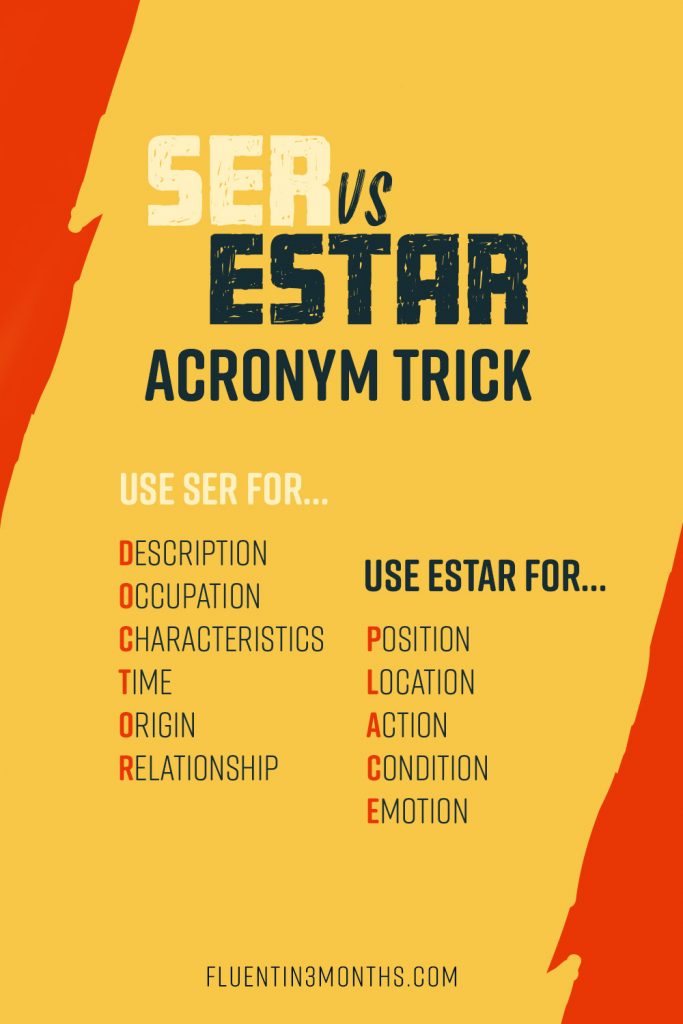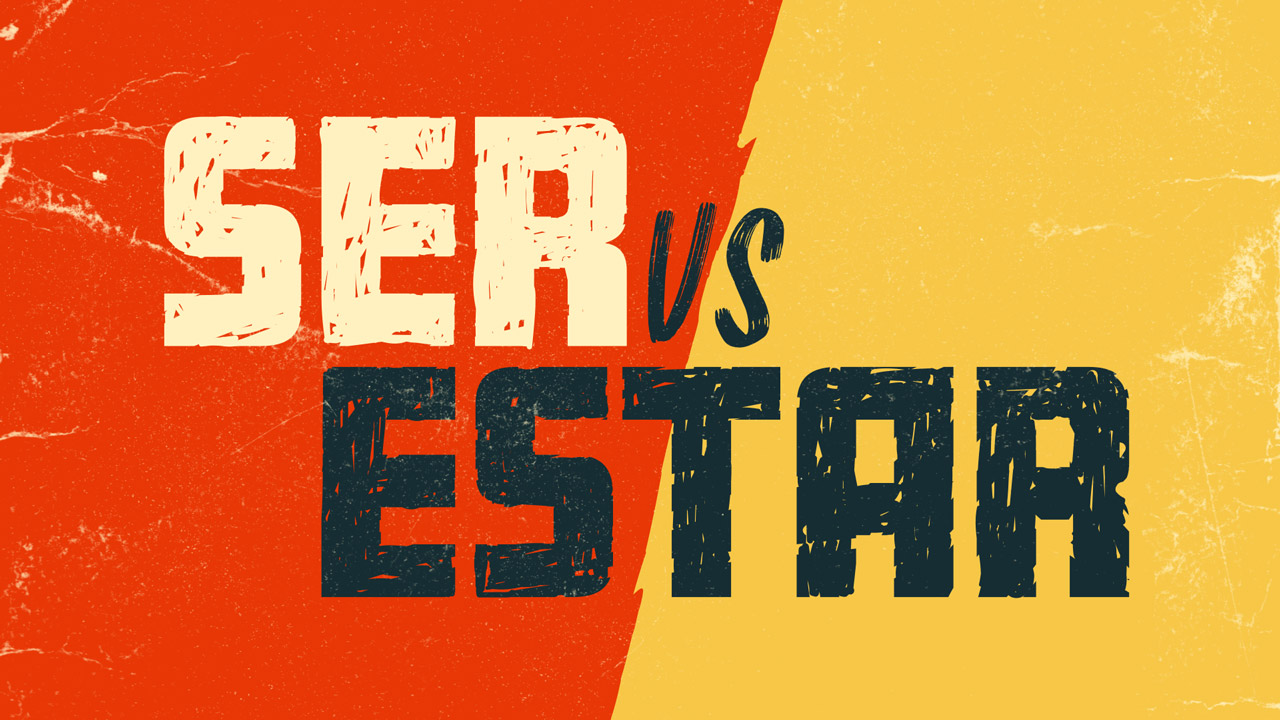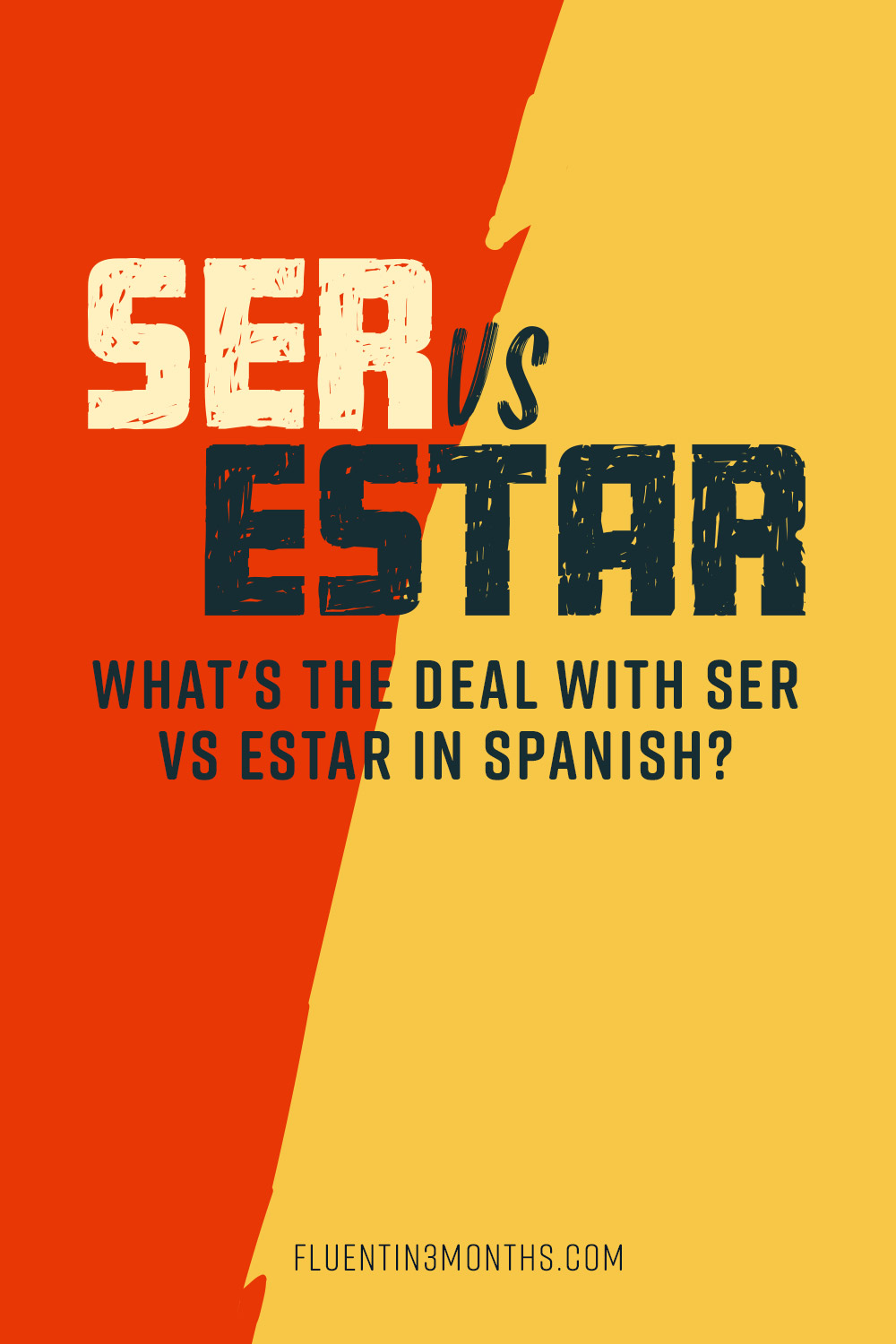What’s the Deal with Ser vs Estar in Spanish?
Ser vs. estar… If you’re learning Spanish, you’ve probably gotten one or ten migraines from this topic already. What a killjoy.
You’re not alone: all Spanish learners struggle with ser vs. estar. I know I did.
In this post, you will learn:
- when to use ser vs. estar
- a pair of ser vs. estar acronyms that will help you memorize the previous point
- ser vs. estar conjugation
- how to efficiently practice ser vs. estar
And I also know what you’re thinking: Spanish conjugation is already tricky enough. Why did it have to have two verbs for “to be”?
Long story.
But don’t worry, I’m here to help. I’ve prepared a simple, go-to guide for you. After reading this post, getting rid of the ser vs. estar confusion will only be a question of practice.
To make sure you’re truly on good terms with ser and estar, I’ll even tell you why there are two verbs for to be in Spanish.
Ready to dive in?
Great! Buckle,up get ready, and welcome to the Fluent in 3 Months Spanish rollercoaster. The ride’s on the house 😉
When to Use Ser vs. Estar:
We’re just beginning on this roller coaster ride, and have the task of making it up the first hill… And that would be learning when to use ser vs. estar in Spanish.
So hold my cotton candy while I explain.
The Rules With Ser and Estar
The ser vs. estar rules are vague and will try to scare you off, but don’t let them. It’s all a question of practice.
Most of the time, ser is used to describe a permanent state and estar a temporary one. Think of it as ser describing when something is and estar when something is being.
(Keep in mind that this is not necessarily how you would translate them in sentences.)
Examples:
- Soy feliz (“I am a happy person / I have a happy disposition”) vs. Estoy feliz (“I am happy at this moment”).
- El invierno es frío (“Winter is cold”) vs. El día está frío (“This day is cold right now”).
- El agua es clara (“Water is clear”) vs. Está claro que entiendes (“It’s clear that you’re understanding”).
Ser is the “identity” or “nature” verb: Soy Benny (“I am Benny”), Soy un hombre (“I am a man”), Los parques de aventura son geniales (“Adventure parks are amazing.”)
Estar is the “in process” or “at this moment”: Estoy feliz de estar ayudando (“I am happy to be helping.”)
Remember that I said this applies most of the time, though. Sometimes, estar is used to describe permanent things, such as something’s location: Mi casa está del otro lado del río, (“My house is on the other side of the river.”)
Alright, pull on the brakes for a second. We’re on top of a high hill now and you probably feel like we’re coming to a standstill.
But us rollercoaster fans know this is when the ride really begins.
Ser vs. Estar: Acronym Trick
Fun loop time! Did you really think I would leave you perched on that hill with a big question mark hovering over your head?
Like I said, ser vs. estar rules are vague, but Spanish learners have come together and found a way to make them easier. And that’s with… Acronyms!
Acronyms are words made out of other words’s initials. In our case, we will use the acronyms D.O.C.T.O.R. and P.L.A.C.E.

When to Use Ser: If Ser Is Giving You a Headache, Think of Your Doctor
The acronym that will help you remember when to use ser in Spanish is D.O.C.T.O.R.
Here’s how this acronym stands for:
Description → Describe something or someone’s quality (usually in appearance) that is unlikely to change anytime soon.
Example: Mi pelo es castaño – “My hair is short.*
Occupation → Describe what a person does for work or as a hobby.
Example: Soy un viajero – “I am a traveler.”
Characteristics → Describe a person’s character and personality.
Example: Mi amigo es divertido – “My friend is funny.”
Time → Tell what time it is: hours, special date, etc.
Examples: Son las dos (“It’s two o’clock”) and Hoy es mi cumpleaños (“Today is my birthday”).
Origin → Where a person or thing comes from.
Example: Soy de Irlanda – “I am from Ireland.”
Relationship → Describe a person’s ties and relationships.
Example: Matt es mi amigo – “Matt is my friend.”
When to Use Estar: If You’re Lost with Estar, Think of Your Favorite Place
The acronym that will help you to remember when you have to use estar, P.L.A.C.E., and it stands for:
Position → Say where or in what position something or someone is.
Example: Estamos sentados en el vagón – “We are seated in the wagon.”
Location → Describe where a thing or person is on a map or according to your surroundings.
Example: El parque está en el medio de la ciudad – “The park is in the middle of the city.”
Action → Make use of the present progressive or any other progressive tense. We’ll talk about this more in depth later.
Example: Nos estamos divirtiendo – “We are having fun.”
Condition → Describe a temporary mood.
Example: Mi amiga está cansada – “My friend is tired.”
Emotion → Describe present feelings.
Example: Estoy feliz de estar aquí – “I am happy to be here.”
When Ser and Estar Are Auxiliary Verbs
There is another situation in which you need to choose between ser and estar: when you need an auxiliary verb.
Auxiliary verbs, also known as helping verbs, help forming compound tenses.
The English auxiliary verbs are:
- to be: “I am being.”
- to have: “I have done.”
- to do: “I did go.”
Spanish has three auxiliary verbs as well, except two of them translate to “to be” in English:
- haber (“to have”)
- ser
- estar
This is a significant moment of our rollercoaster ride through ser and estar. Luckily for you, it’s quite easy to go through.
Estar: Spanish’s Favorite “To Be” Auxiliary Verb
Most of the time, compound tenses that require a “to be” auxiliary verb in Spanish will use estar. This is because one of the most common compound tenses in Spanish are the progressive tenses.
I told you we would talk about it more in depth, so here we are.
These are all the progressive tenses in Spanish that use the auxiliary verb estar:
- Present progressive: Estoy haciendo (“I am doing”)
- Imperfect progressive: Estaba haciendo (“I was doing”)
- Preterit progressive: Estuve haciendo (“I have been doing”)
- Perfect progressive: Había estado haciendo (“I had been doing”)
- Future progressive: Estaré haciendo (“I will be doing”)
- Conditional progressive: Estaría haciendo (“I would be doing”)
- Subjunctive progressive tenses: Esté haciendo (“I am/would be doing”)
As you can see, the various progressive tenses follow the following pattern:
appropriately conjugated estar + verb gerund
Wait! Don’t jump from the wagon yet. These big words might sound complicated, but the tenses are actually quite easy to build.
First step is knowing your estar conjugations, and I’ve got you covered. I’ll talk about them in detail later.
Gerunds are also simple to make: take the root of the verb and add a standard suffix:
- -ando if the verb belongs to the first group, i.e. ends in -ar
- -iendo if it belongs to the second or third group, i.e. ends in -er or -ir
Examples: Estoy caminando (“I am walking”) and Estaremos comiendo (“We will be eating”).
Jump to this article if you want to learn more about Spanish verb groups!
Extra knowledge: In some Hispanic regions, you might hear phrases such as voy caminando hacia tu casa (“I am walking towards your house”) or fui preparando la cena (“I was preparing dinner”). This is another way to form progressive tenses, but not one you would find in grammar books. As always, I will advise you to listen-and-learn: observe how the locals do it.
Ser: Spanish’s Passive Voice Auxiliary Verb
In Spanish, ser is mostly used to form the passive voice as an auxiliary verb.
The passive voice happens when the subject of the sentence is ‘suffering’ the action rather than doing it: The apple is being eaten.
In Spanish, the passive voice is formed according to this format:
appropriate ser tense + past participle
Examples:
- Las casas fueron destruidas – “The houses were destroyed.”
- El hombre es acompañado por su esposa – “The man is accompanied by his wife.”
- La comida será calentada por mi abuela – “The food will be heated by my grandmother.”
Just as I told you with estar and the progressive tenses, the passive voice is very easy to form.
In the next section, I will teach you how to conjugate ser.
But for now, here is how you form most of the past participles in Spanish: verb infinitive + appropriate suffix:
- -ado if the verb belongs to the first group, i.e. ends in -ar
- -ido if it belongs to the second or third group, i.e. ends in -er or -ir
¡Ojo! This is the base of the passive voice. However, remember that gender and number are important in Spanish. That applies to passive voice.
If the subject of the sentence is:
- masculine singular, the suffix ends in -o.
- feminine singular, the suffix ends in -a.
- masculine or mixed plural, the suffix ends in -os.
- feminine plural, the suffix ends is -as.
Ser vs. Estar: Conjugation Tables
If you really want to know all about the ser vs. estar topic, you have to become familiar with the verbs’s conjugation.
I wasn’t going to let you fend for yourself on this one, so I put together two conjugation tables, one for each verb. You can learn the principal tenses of ser and estar right here.
Before the fun, though, refresh your memory by looking over the Spanish subject pronouns.
| yo | I |
| tú | you, informal singular |
| vos | you, informal singular in som Latin American countries |
| él / ella / usted | he / she / you, formal singular |
| nosotros / nosotras | we, masculine / we, feminine |
| vosotros / vosotras | you, informal plural only in Spain, masculine / you, feminine |
| ellos / ellas / ustedes | they, masculine / they, feminine / you, plural |
Now you’re ready to dive into the conjugation.
| Indicative Present | Indicative Preterite | Indicative Imperfect | Indicative Future | Indicative Conditional | Subjunctive Present | Subjunctive Imperfect | |
|---|---|---|---|---|---|---|---|
| yo | soy | fui | era | seré | sería | sea | fuera |
| tú | eres | fuiste | eras | serás | serías | seas | fueras |
| vos | sos | fuiste | eras | serás | serías | seas | fueras |
| él / ella / usted | es | fue | era | será | sería | sea | fuera |
| nosotros / nosotras | somos | fuimos | éramos | seremos | seríamos | seamos | fuéramos |
| vosotros / vosotras | sois | fuisteis | erais | seréis | seríais | seáis | fuerais |
| ellos / ellas / ustedes | son | fueron | eramos | serán | serían | sean | fueran |
| Indicative Present | Indicative Preterite | Indicative Imperfect | Indicative Future | Indicative Conditional | Subjunctive Present | Subjunctive Imperfect | |
|---|---|---|---|---|---|---|---|
| yo | estoy | estuve | estaba | estaré | estaría | esté | estuviera |
| tú/vos | estás | estuviste | estabas | estarás | estarías | estés | estuvieras |
| él / ella / usted | está | estuvo | estaba | estará | estaría | esté | estuviera |
| nosotros / nosotras | estamos | estuvimos | estábamos | estaremos | estaríamos | estemos | estuviéramos |
| vosotros / vosotras | estáis | estuvisteis | estabais | estaréis | estaríais | estéis | estuvierais |
| ellos / ellas / ustedes | están | estuvieron | estaban | estarán | estarían | estén | estuvieran |
Ser vs. Estar: Spanish Wanted to Confuse You… Or Did It?
I will briefly answer the question you asked at the beginning of the post: Why does Spanish have to have two verbs for “to be”?
Hold on to your hat, because we’ve got one last big loop on this ride.
Have you ever heard of the ‘romance copula’? It’s a grammatical term used, among other things, to describe the existence of two verbs “to be” in romance languages.
Yes, you’ve read it right! Other language learners have the same issue as you do, including Portuguese and Italian students.
Let’s take a step back for a second and talk about copula verbs. The word copula comes from Latin and it means “link”. A copular verb is a verb that connects the subject of the sentence to a compliment.
We have those in English too, with “to be” being the main one.
Some romance languages have however developed extra copula verbs. These are derived from Latin verbs that didn’t necessarily start their life as “to be” verbs: sedere (“to sit”), stare (“to stay”), and esse (supletive “to be”).
Because esse was highly irregular and sedere shared some of its conjugations, they eventually merged into essere, which became the verb for “to be” for a permanent or essential concept.
Stare instead took the meaning of “to be” in a temporary or incidentally way.
In Spanish, essere became ser and stare became estar.
Ser vs. Estar: Practice
We’re coming to the end of our ride, but I can’t let you go before saying this: The only way you will be 100% at ease with ser vs. estar is if you practice.
Hispanics don’t learn the rules for ser and estar. They simply learn which sounds more right to them, it becomes instinctive. Ultimately, this is what you need to do as well.
Remember that making mistakes is the ONLY way to learn a language. I share more about this in this post.
Es Momento de Despedirnos – “It’s Time to Say Goodbye”
Did you enjoy the Fluent in 3 Months Ser vs. Estar rollercoaster? As you could see for yourself, it’s one of our most topsy-turvy rides. It wasn’t simple, but we ended up bouncing back on track after each weird turn.
Is the topic crystal clear to you now? Which ser vs. estar chart did you like the most? Let me know in the comments!
If you’re ready to start another adventure, let me give you some advice.
Learning alone isn’t fun. Having to face a whole new language on your own isn’t easy.
If you’re serious about learning Spanish, you may want to find an appropriate support for your progression. Check out my list of the best resources for Spanish learning: it’s full of materials that will help you go faster and farther.
And you can always join our Fluent in 3 Months Challenge! We have a tight-knit and supportive community that will help you speak Spanish in real conversations.
Ok, well… Time to go! I have another ride to prepare 😜
¡Hasta luego!




Social